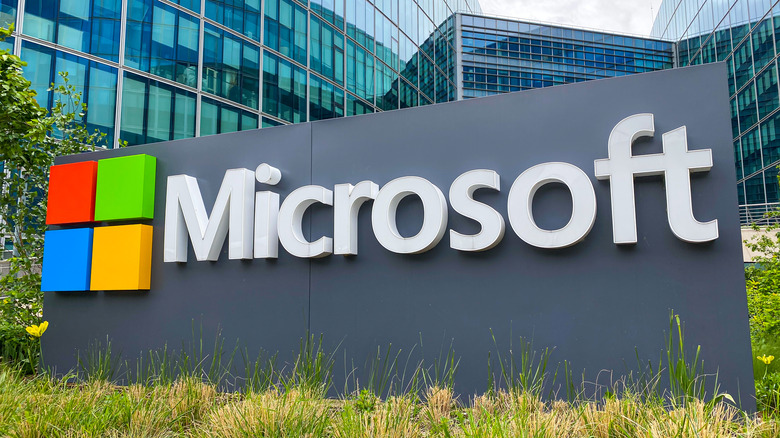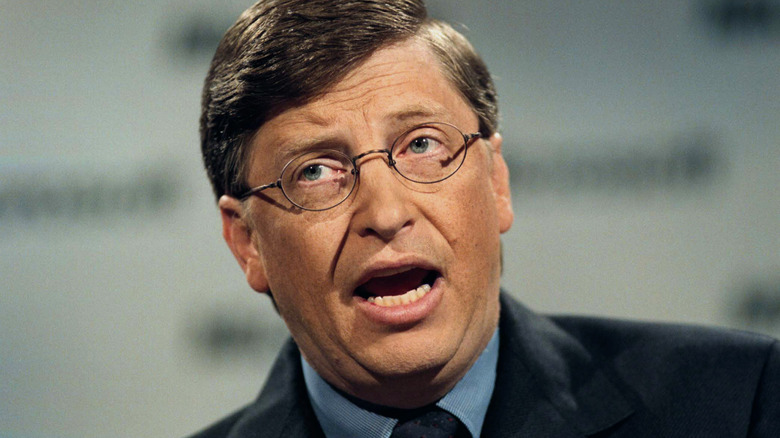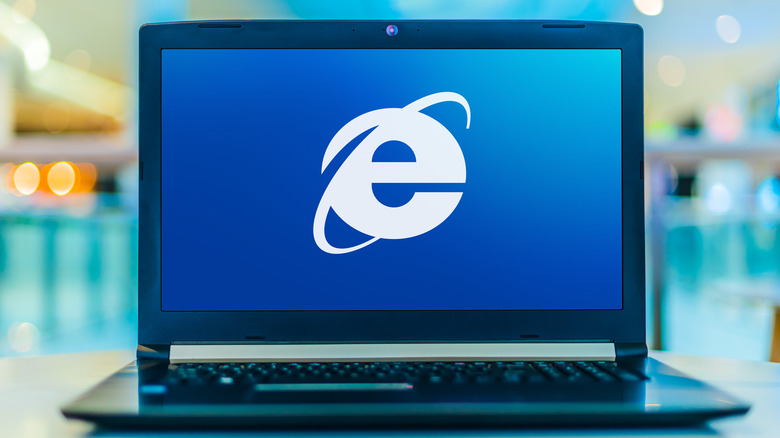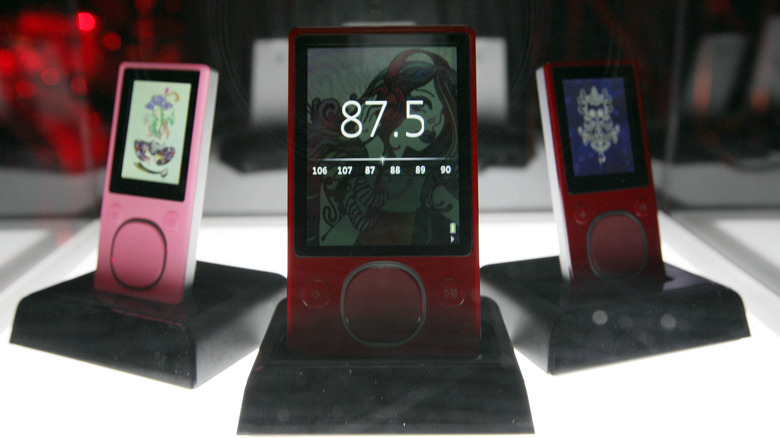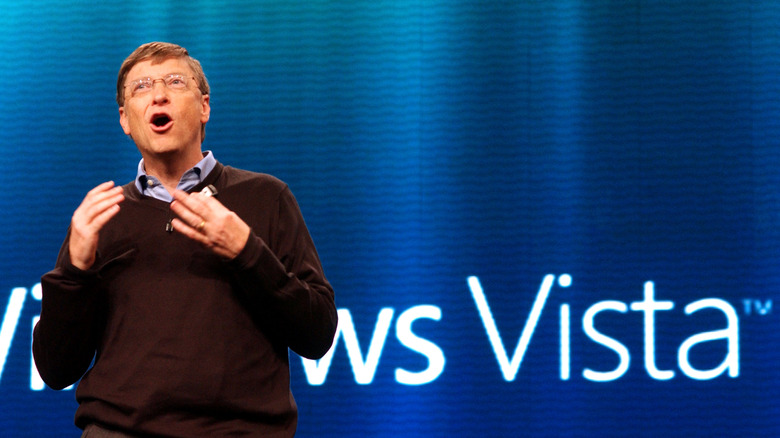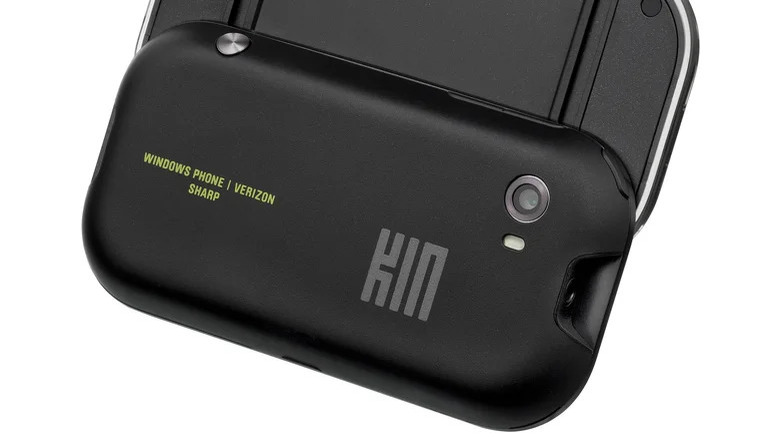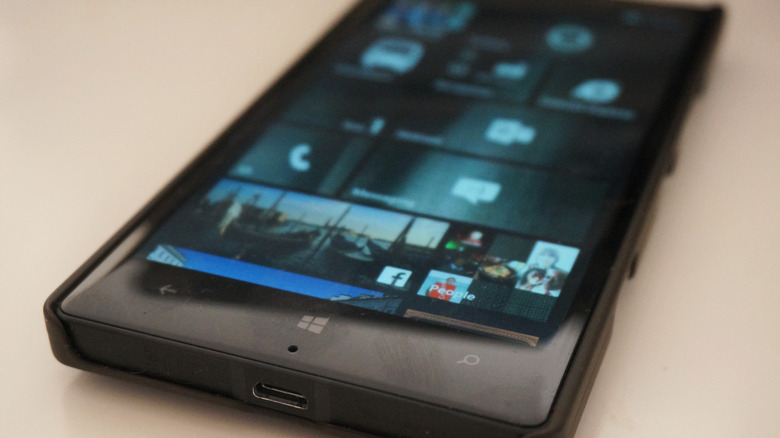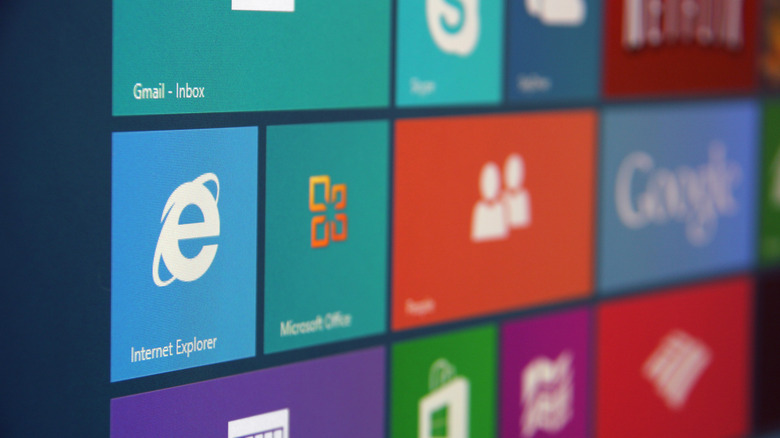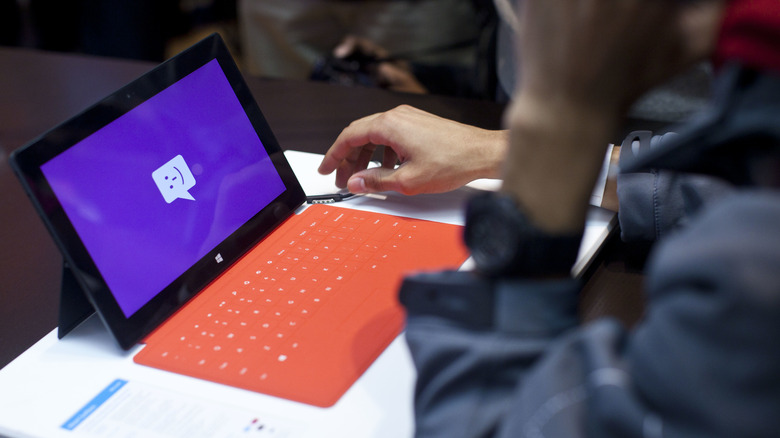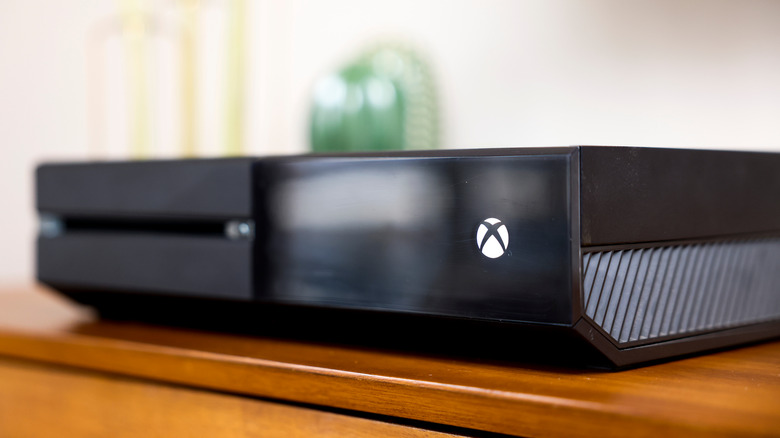10 Of The Biggest Mistakes Microsoft Has Ever Made
To call Microsoft one of the most influential companies of the past 30 years might be an understatement. The tech giant dominated the home computer gold rush of the 1990s with its Windows operating system, turning Bill Gates from a college dropout to a household name, and has consistently dominated that market ever since. But while it may be the so-called "800-pound gorilla," the Redmond-based tech company has made plenty of missteps.
When Microsoft mucks something up, it tends to do so in spectacular fashion. Many of its biggest bungles are the stuff of tech-industry legend, still spoken about today as cautionary tales about flying too close to the sun. Some are products so bizarre they seem like parodies of themselves, while others ended with court cases that took the nation by storm. Then, there are Microsoft's seemingly endless failures in the smartphone market, and a few great products released before the public was ready for them.
In chronological order, these are 10 of the biggest mistakes Microsoft has ever made.
Microsoft Bob
Microsoft Bob was a graphical shell overlaying Windows meant to make the operating system easier to use for non-techies. Users were presented with a digital house and clicking on items inside opened relevant programs. For example, clicking on the wall calendar launched (you guessed it) the calendar. The Washington Post called it "sterile." It quickly became one of the most hated products the company ever released, as evidenced by Time listing it among the "50 Worst Inventions." While it has largely been forgotten in the years since its 1995 launch, tech veterans remember it as a laughable attempt to make Windows more accessible to the masses. Whatever the goal, it was a hideous failure of skeuomorphic design that condescended to users by treating them like toddlers. Microsoft quickly discontinued Bob and tried to pretend it never happened.
While the product became a bizarre joke, Bob should be understood in the context of its time. In 1995, households were only beginning to adopt PCs, and users who had never encountered a graphical user interface were often unable to master Windows on their own. Understandably, Microsoft wanted an experience to ease newcomers into computer use. But it seems fair to say that a program called Bob featuring a rat named Scuzz wasn't the best implementation of that idea.
Oh, did we not mention Scuzz yet? Along with Clippy the paper clip and another anthropomorphized helper called Rover the Dog, Scuzz the Rat was included with Bob. According to The Washington Post, Bob introduced Scuzz by saying, "The worst insult you can give to this stupid, rabid rat is to like him. Scuzz would rather wear a suit in public than be your friend." With that context, Bob's failure makes even more sense.
Monopolizing in the 90s
The mistake that still haunts Microsoft is its own early success. In 1998, Bill Gates would be dragged before Congress to answer for his company's monopolistic behavior, and his company would be taken to court in the landmark United States v. Microsoft Corp case, which nearly ended with the company forcibly disbanding.
The story begins earlier in the '90s. It's hard to overstate the juggernaut Microsoft was in those days. Riding roughshod over the nascent PC market, which it was becoming clear would be the defining technology of the future, the company tightly controlled its products and the distribution thereof. Former Netscape CEO Jon Mittelhauser, whose company was one of many crushed by Microsoft, told The Ringer, "They were the 800-pound gorilla." Combined with Bill Gates' reputation for braggadocio, this drew the attention of the Clinton-era Justice Department, which in 1994 entered a consent decree against Microsoft intended to limit the company's hold over computer manufacturers. Gates scorned the decree, saying it would change nothing, as recorded by The Washington Post.
Gates' continued belligerence was a bad move. If Washington had it out for him before, their appetite was further whetted, and on May 18, 1998, an antitrust suit was filed against Microsoft by the Department of Justice in conjunction with 20 state attorneys general. The suit alleged Microsoft had abused its monopoly on the market to control internet browsers.
In November 1999, a shocking decision: Judge Thomas Penfield Jackson ruled that Microsoft had indeed abused its power over the market. Even more shocking, he ruled that Microsoft should be split into two companies. But the breakup never happened. In 2001, under the Bush administration, an appeals court reversed the Jackson decision, and Microsoft was spared the axe.
Internet Explorer
Internet Explorer has become one of the most maligned pieces of software in Microsoft's history. For a good portion of the time, it had a massive monopoly over the browser market due to the company's anticompetitive practices. It was written into Windows in such a way that removing it would handicap the OS, according to those familiar with the situation who spoke with The Ringer.
Not only was Internet Explorer a bloated application, but it was also riddled with security vulnerabilities that gave a direct path of attack for the endless malware Windows was once known for attracting, with one security researcher calling it "a ripe attack surface for initial entry into Windows machines" even after Microsoft retired the browser in 2022.
Today, the most popular browser by a long shot is Google Chrome, which first surpassed Internet Explorer in market share back in 2012. As anecdotal proof that hatred of Internet Explorer had become widespread, remember that to install Chrome, most users had to first open Internet Explorer to download it.
To recap, Microsoft was so zealous about winning the browser wars that it incurred a historic antitrust suit over Internet Explorer. And yet, a little over a decade later, consumer opinion had soured on Microsoft's browser to such an extent that Google was able to swallow it whole. As a cherry on top, the default browser on Windows, Microsoft Edge, now runs on Chromium.
Zune
If you owned a Zune, especially one of the excellent second-generation models, it's hard not to feel a sting of defensiveness when people mock Microsoft's failed media player. Sure, the product line ultimately got scrapped after only a few years, but the problem wasn't with the devices themselves. The Zune simply found itself up against a juggernaut, the Apple iPod, and its qualities were too esoteric to be appreciated in their time.
The design of the first-generation Zune, released in 2006 did itself no favors aesthetically. It looked like someone skinned a briefcase and dipped it in plastic. Meanwhile, the iPod was the epitome of 2000s chic, the defining gadget of the decade, and the Zune was perceived by the public as drab and unexciting. As SlashGear noted in its Zune retrospective, the iPod's dominance was too much for Microsoft to overcome, especially as a late presence in the market. Even the refined design of the second-generation Zune 4/8 and Zune 80, which had satisfying trackpads and gorgeous software that made the iPod's interface look instantly dated, couldn't save the lineup.
On one hand, it's a shame the Zune failed. It was ahead of its time, the Picasso of media players. While the iPod had to be physically connected to a computer to sync music, the Zune could do so over Wi-Fi. You could send songs, photos, and more to nearby friends, which feels like an early version of AirDrop. But most importantly, years before anyone knew what Spotify was, Zune Pass offered a-la-carte subscription-based music streaming, and you could permanently keep 10 tracks a month. Microsoft predicted the future of music consumption but got there too early. If Zune Pass had only stuck things out a few more years, it might have cornered the nascent streaming market.
Vista
When Microsoft released Windows Vista in late 2006, the company was in a dominant position. Vista's predecessor, Windows XP, was the most popular version of Windows ever at that time, peaking with 80% market share, and consumers were excited to see what Redmond had in store. But Vista quickly soured for both tech enthusiasts and the general public, developing a reputation for sluggish performance. As noted by The Guardian, the larger system size, extra background processes, and reliance on DirectX to process the slick new animations all added up to an operating system that got bogged down on suboptimal hardware.
There's a case to be made that Vista wasn't a bad OS. Its Aero design language was gorgeous, though of course beauty is in the eye of the beholder, and it added features like more robust indexing and search that were sorely needed to modernize Windows. Ars Technica praised Vista's "many low-level changes to improve the experience of using the OS." However, many users coming from XP didn't realize how demanding it would be on their older systems. Additionally, many vendors sold Vista machines with a "Windows Vista capable" label which was the subject of a class-action lawsuit by users who claimed the machines couldn't run Vista at acceptable speeds, though a judge eventually dropped that status.
Amid so much controversy, it took Windows 7 to restore Microsoft to good graces with its customers. Maybe Vista was a truly bad OS, or maybe it was too advanced for the hardware most consumers had at the time of its release. Either way, it remains a black stain on Microsoft in the public consciousness.
Microsoft Kin
Microsoft's CEO has admitted its failures with Windows Phone, but one mobile product the company almost certainly wants memory-holed is the Kin. Originally meant as the spiritual successor to the T-Mobile Sidekick after Microsoft bought Danger, the Microsoft Kin was an ill-conceived pair of feature phones marketed toward teens in 2010. As with most products marketed toward young people but cooked up by a company of stodgy businesspeople, it was dripping with "How do you do, fellow kids" type energy. Since the youngins were into a hip new fad called social media, the devices were marketed as "social phones," which basically meant putting a Facebook feed on the home screen, though the phone couldn't run apps.
The Kin came in two variants, Kin One and Kin Two (were they going for a "The Cat in the Hat" pun?) with the former being slightly more compact and both having slide-out keyboards. The software was another head-scratcher. Although the Sidekick had its own platform, Microsoft saddled the Kin with Windows CE, which was already on its way out to be supplanted by Windows Phone.
It's unlikely anyone would have wanted a Kin in the first place, but Microsoft further damaged the product with terrible marketing. Look no further than the bizarre and cringe-inducing ad spots that seemed to be encouraging sexting on the devices, one of which showed a teenage boy taking a risqué photo and sending it to a potential paramour. Ultimately, the device was pulled from partner stores after a mere 48 days, with sales estimates ranging from as high as 10,000 units to as low as 500, making it one of the most confounding mistakes in Microsoft history.
Windows Phone
Microsoft CEO Satya Nedella has noted his regret for the moves Microsoft made in the smartphone sector (via Business Insider). When the iPhone first launched with Android quick on its heels, Redmond was still trying to sell Windows Mobile, a relic from the days of BlackBerry and Palm designed with enterprise clients in mind. Finally, in 2010, Windows Phone was introduced to replace it, but it was too late.
The story of Windows Phone is a bit like that of the Zune. While it was a truly gorgeous and fluid operating system that was offered on some equally stunning hardware like the Nokia Lumia 1020, it simply arrived too late to the market with features that couldn't be appreciated by most consumers. It's also possible that bad blood from Windows 8 spilled over, since Windows Phone carried the same Metro design language and had the same version numbers as the desktop OS.
The real nail in Windows Phone's coffin was app support. Even the best OS is only as good as the apps it can run, and as was widely reported during its lifespan, Microsoft simply couldn't get developers on board. App development is hard work, and developers didn't want to add support for a platform with so little market share. Smartphone buyers, meanwhile, don't want to buy a phone that won't run their favorite apps. It was a negative feedback loop that became a death spiral. The Windows Phone was retired in 2017, and more recent phones from the company like the Surface Duo and Duo 2 have shipped with Android instead.
Windows 8
In trying to preempt a world of touchscreens, Microsoft vastly overestimated consumer desire for a touch-centric desktop OS. The result was Windows 8, an operating system that tried to do everything and failed to do any of it well.
When Windows 8 bowed in 2012, Microsoft was in a strong position. Windows 7 had been a roaring success, and the company could have released another, nearly identical OS and called it a day. But not content to dominate the PC market, the software giant decided it wanted to put a nail in the iPad's coffin, too. Thus, the Metro UI was born, replacing the Start menu with a full-screen Start screen and relegating the desktop to obscurity among a sea of touch-friendly tiles.
The OS ultimately confused long-time Windows users by upending decades of UI familiarity. As SlashGear noted, hiding important elements like the "Start" button behind touch gestures was confounding even to veteran Windows users, especially those using a mouse and keyboard. ZDNet called it "terrible, horrible, painful and execrable," while Ars Technica said it was "extremely ambitious" but ultimately had "compromises everywhere." While not all reactions were negative, Microsoft ended up backpedaling a lot of Windows 8's boldest design choices in Windows 8.1.
Windows RT and Surface
Taken aback by Apple's success with the iPad, Microsoft rampaged into the tablet market with a strategy that feels half-baked in retrospect. Alongside Windows 8, the company released Windows RT, a version of the OS designed to run on ARM chips. But Windows RT, despite looking a lot like Windows 8, could not run x86 applications. It was launched alongside the first-generation Surface in 2012, and already we can see the problem. Microsoft did a terrible job of communicating what the product was capable of, so many customers bought a Surface only to discover that their new Windows device couldn't run their usual Windows programs. Microsoft later admitted the naming had been confusing (via ARN).
As explored elsewhere in this article, Windows 8 was confusing on its own, since its interface was radically different from previous versions. Fragmenting it into a "full" and "mobile" version only muddied the waters further. Microsoft even had to train its own staff on the differences between Windows 8 and RT, so it's easy to imagine someone less familiar with tech would have been boggled.
Windows RT's support lifecycle ended in 2016, with the last RT device, the Surface 2, released in 2014. It feels like a blip in history now, but RT demonstrates the self-inflicted problems Microsoft has always faced in attempting to break into the mobile space.
Xbox One
It's hard to call the Xbox One a total failure, but it certainly represented a low point for Microsoft's gaming hardware. As the successor to the Xbox 360, gamers were expecting shock and awe from the next-generation console. A bizarre launch event in 2013 turned consumers off from the get-go by focusing far too much on the Xbox One's streaming capabilities. The keynote was summed up by online jokesters as, "TV TV TV sports Call of Duty," and things didn't get better from there.
Among other irritants, the Xbox One required a constant internet connection, had a draconian games licensing system, and cost $100 more than the PlayStation 4. On top of that, it angered users by foisting the Kinect camera system onto them, which was part of the reason they cost more than the competition.
The result of all that mismanagement: the Xbox One series was handily trounced by the PS4 in sales. In August of 2022, court documents from Brazil revealed that Microsoft's console sold fewer than 58.5 million units, while the PlayStation 4 sold a staggering 117.2 million before Sony stopped counting.
Microsoft phased out the Xbox One only recently in mid-2023, so clearly it had a long shelf life, but its legacy will forever be as the device that handed Sony an open lane to console domination.
